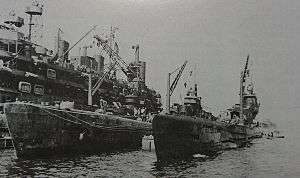Japanese submarine I-401
 I-401 beside USS Proteus (left) and I-14 (right), on 29 August 1945. | |
| History | |
|---|---|
| Name: | I-401 |
| Commissioned: | 8 January 1945 |
| Fate: |
|
| General characteristics | |
| Class and type: | I-400-class submarine |
| Displacement: |
|
| Length: | 122 m (400 ft) |
| Beam: | 12 m (39 ft) |
| Draft: | 7 m (23 ft) |
| Propulsion: |
|
| Speed: |
|
| Range: | 37,500 nmi (69,400 km) at 14 kn (16 mph; 26 km/h) |
| Test depth: | 100 m (330 ft) |
| Complement: | 144 |
| Armament: |
|
| Aircraft carried: | 3 × Aichi M6A1 Seiran sea-planes |
The Sen Toku-class I-401 (伊号第四百一潜水艦) was once the largest submarine in the world. It was commanded by Lieutenant Commander Nobukiyo Nambu of the Imperial Japanese Navy during World War II. Capable of carrying three two-seat Aichi M6A1 "Seiran" (Mountain Haze) float torpedo bombers, the Sen Tokus were built to launch a surprise air strike against the Panama Canal.
Service history
When I-401 was completed and commissioned on 8 January 1945 in the Kure Naval District, the Second World War was almost over. This left the fate of I-401 uncertain. After several attempts to launch, I-401 set course for its first target, but was stopped by Emperor Hirohito's broadcast, calling for an end to all hostilities on 15 August 1945.
On 26 August 1945, I-401 hoisted a black flag of surrender. Its unmanned planes were catapulted into the sea, all 20 Type 95 torpedoes were destroyed, and all codes, logs, charts and secret documents were also destroyed.
Three days later, on 29 August 1945, I-401 was picked up on USS Segundo's radar. I-401 surrendered to the US ship. Lieutenant Commander Nobukiyo Nambu delivered two katana, as a symbol of surrender, to Lieutenant John Edward Balson, Segundo's Prize Crew officer.
I-401 was finally sunk, when used as a target ship, off Pearl Harbor on 31 May 1946.
Rediscovery
On 17 March 2005, the Hawaii Undersea Research Laboratory's (HURL) deep-diving submersibles Pisces IV & Pisces V located I-401 off the coast of Kalaeloa. I-401 lies about 820 metres (2,690 ft) off the coast of Barbers Point. The bow is broken off just forward of the aircraft hangar. The two pieces are not far apart and are connected by a debris field. The main hull is sitting upright on the bottom, the numbers "I-401" are clearly visible on the sides of the conning tower. Her 25 mm anti-aircraft guns seem in almost perfect condition.
References
- ↑ Campbell, John Naval Weapons of World War Two ISBN 0-87021-459-4 p.191
External links
- HURL I-401 page
- Japanese SuperSub Documentary produced by the PBS Series Secrets of the Dead